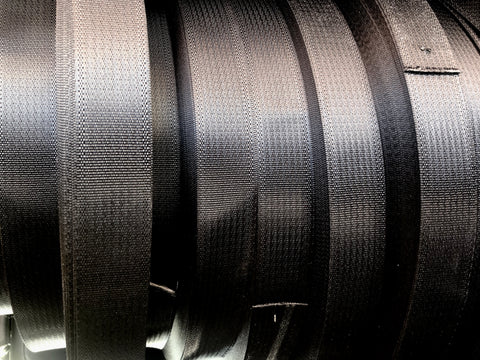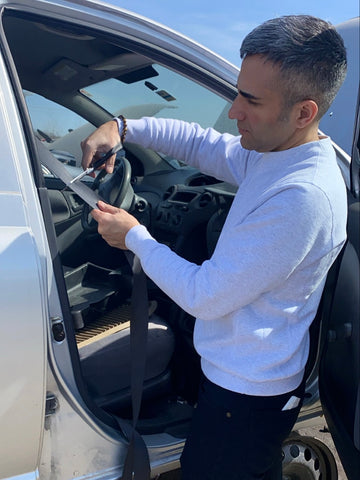
It’s no secret that the automotive industry creates a lot of waste. We often associate this waste with the pollution caused by driving, and less with the fact that every car that is retired from the road ends up in a scrapyard. The metal left in landfills from cars taken off the road poisons the soil, and are actually affecting the biodegradability of organic pollutants, doubling their polluting effect. That doesn’t take into account all of the other materials that get thrown away with the car, such as nylon carpeting, cushioning materials for seats, and of course, seatbelts.

Rolls of seatbelts before they are upcycled into bags and winter coats
An innovative solution to this issue is to repurpose some of these materials into something new that can continue to be useful. There is immense opportunity to create and upcycle seatbealts due to their incredibly durability. They are designed to save lives and are built to be indestructible, which are the same qualities we would like to offer in our products (well saving lives is kind of a stretch… But we can do our best). Not only is this a creative solution that benefits the environment, offering a durable product also greatly benefits our customers. When investing in staple pieces like winter coats or an every-day-bag, you want to know that they won’t need to be replaced for a very long time, or even ever.

Inder, our founder, retrieving seatbelts from a scrapyard in Laval
At BEDI seatbelts are at the core of our design process, and even our brand identity - our logo is inspired by the shape of our seatbelts. Our founder, Inder, often says that BEDI was born in the scrapyard. Walking through the post-apocalyptic landscape of a scrapyard in Laval, he was inspired to find a way to repurpose and give a second life to at least some of that man-made trash in some way.
After retrieving the seatbelts from scrapyards or sourcing rejected seatbelts from North American car or airplane manufacturers, they are thoroughly cleaned before being used in our designs. That’s it, believe it or not. Seatbelts are incredibly dense and durable, and it is extremely difficult to alter their appearance by dying them or trying to puncture them in any way. There is such a large amount of them readily available to be recycled that we are never in short supply. We use them in all of our designs - from our bags, to our winter coats, and even in the creation of the furniture and the architecture of our new store in the Mile End.

The EARHART Duffel bag, made of upcycled leather from Air Canada seats and upcycled seatbelts
On any bag, the straps are always the first to go. They are the most common part to snap or tear because they are the most handled part of the piece. We decided to use seatbelts for all of our straps to ensure we can maintain a minimalist design while also allowing our pieces to keep up with our utilitarian needs.

After a lot of research, we have also been able to finally source seatbelts in many unique colours other than black. Stay tuned for more colours in the styles you love, coming soon!

